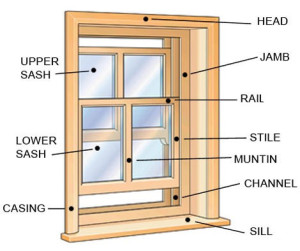Small Home Gazette, Spring 2014
Painting Double-Hung Windows So They Remain Functional
Follow the paint manufacturer’s instruction regarding preparation of surfaces and application of paint. Avoid disturbing paint that contains lead. If you do, take proper precautions. Information can be found on government websites such as: “Steps to Lead Safe Renovation, Repair and Painting.”
 General Rule:
General Rule:
Paint all parts of the sashes and frame that are exposed when the windows (both upper and lower sashes) are in the closed position. Do not paint over seams between moving parts, rather cut in from both sides towards the seam. This will avoid paint wicking into the seam and sealing the window shut.
Three Exceptions:
- Paint the exterior window sill normally covered by closed lower sash (raise lower sash).
- Paint the bottom of the lower sash.
- Paint the meeting rail faces (center horizontal bars where upper and lower sash meet) which are visible when the windows are opened (facing in).
After painting, while the paint is still wet, gently move the sashes up and down a few times. Let the paint dry with both sashes opened a few inches. If sticking occurs, use a thin putty knife; gently slide it in between the stuck surfaces in order to break through the offending bead of paint.
Hardware:
Do not paint the locks, handles, wheel of the pulley, the ropes, or the metal weather stripping (if present). Locks and handles should be removed prior to painting; all other hardware covered with masking tape.
Paint on to the Glass:
To enhance the lifetime of wood sashes, the paint, and the glazing compound, paint must extend on to the glass, both inside and outside. This is the final seal that keeps moisture from reaching the wood. Avoiding paint on the glass may result in a “neat” appearance, however it will allow moisture to seep behind the paint and rot the wood. It will also push the paint off from underneath.
Use masking tape (or other masking tools) on the glass, leaving a 1/32″ strip of glass exposed, which will then be covered with paint. This is well worth the time and effort!

Removing excess paint from the window glass. Photos courtesy of Martin Muller, owner of Double-Hung Window Restoration.
An alternative method is to allow paint to get onto the glass. Once the paint dries, place a thin putty knife parallel to the painted surface with the thin edge onto the glass. Use a scraper blade to remove excess paint from the glass on the outside of the putty knife, leaving the thickness of the putty knife of paint on the glass. Make sure the glass is free of dirt or you could scratch the glass with the scraper blade.











